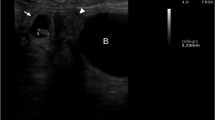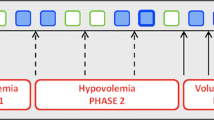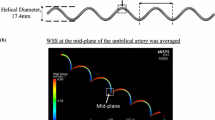Abstract
Objectives
The purpose is to investigate how umbilical arterial blood flow changes by an intraamniotic distilled water infusion and to determine whether the changes in umbilical circulation have any relationship with fetal cardiovascular status and osmolality in amniotic fluid and fetal plasma.
Methods
Eleven chronically catheterizedpregnant sheep were used in this study. After a 1-hour control period, 1.5 L of warmed sterile distilled water was injected over 10 minutes into the amniotic cavity. Fetal heart rate and carotid arterial pressure, blood flow of the umbilical and fetal carotid arteries were continuously measured. Fetal arterial blood sampled twice during the control period and then at 30, 60, 90, 120, 180, 240, 300, and 360 minutes after the start of the infusion, was analyzed for blood gases, pH, plasma electrolytes, and osmolality.
Results
Data obtained from seven sheep with normoxemic fetuses were studied statistically. Umbilical arterial blood flow decreased significantly from 229.5 ± 3.83 mL/min in the control to 167 A ± 11.1 mL/min at 30 minutes after water infusion (P <.001). Umbilical arterial vascular resistance increased rapidly and reached its peak at approximately 60 minutes after infusion and then showed a gradual recovery to the control level (P <.001). Amniotic fluid osmolality had a high degree of correlation with umbilical arterial blood flow and vascular resistance, while fetal arterial blood pressure and heart rate had only little correlation with umbilical blood flow.
Conclusion
A distilled water infusion into the amniotic cavity in near-term pregnant sheep led to an acute drop in umbilical arterial blood flow. The changes in umbilical flow were closely correlated with those in amniotic fluid osmolality. Hemolysis in the capillary networks in the fetal membranes seems to be one of the main causes of umbilical vasoconstriction. It is speculated that the fetal membranes, including capillary networks, intramembranous pathway, and amnion epithelial cells, sense the changes in amniotic fluid osmolality, which leads to a fetal adaptation to the hypotonic environment.
Similar content being viewed by others
References
Cheung CY, Brace RA. Developmental expression of vascular endothelial growth factor and its receptors in ovine placenta and fetal membranes. J Soc Gynecol Investig 1999;6:179–85.
Sagawa N, Hasegawa M, Itoh H, et al. Current topic: The role of amniotic endothelin in human pregnancy. Placenta 1994;15:565–75.
Germain AM, MacDonald PC, Casey ML. Endothelin receptor mRNAs in human fetal membranes, chorionic vessels, and decidua parietalis. Mol Celll Endocrinol 1997;132:161–8.
Germain AM, Attaroglu H, MacDonald PC, Casey ML. Parathyroid hormone-related protein mRNA in avascular human amnion. J Clin Endocrinol Metab 1992;75:1173–5.
Bowers CW. Expression of functional neurotransmitter receptors in an uninnervated tissue: Avian amnion. Cell Tissue Res 1989;258:409–15.
Ognjanovic S, Ku TL, Bryant-Greenwood GD. Pre-B-cell colony-enhancing factor is a secreted cytokine-like protein from the human amniotic epithelium. Am J Obstet Gynecol 2005;193:273–82.
Oger S, Mehats C, Dallot E, Cabrol D, Leroy MJ. Evidence for a role of phosphodiesterase 4 in lipopolysaccharide-stimulated prostaglandin E2 production and matrix metalloproteinase-9 activity in human amniochrionic membranes. J Immunol 2005;174:8082–9.
Matsumoto LC, Bogic LV, Brace RA, Cheung CY. Fetal esophageal ligation induces expression of vascular endothelial growth factor messenger ribonucleic acid in fetal membranes. Am J Obstet Gynecol 2001;184:175–84.
Gilbert WM, Brace RA. The missing link in amniotic fluid volume regulation: Intramembranous absorption. Obstet Gynecol 1989;74:748–54.
Faber JJ, Anderson DF. Absorption of amniotic fluid by amniochorion in sheep. Am J Physiol 2002;282:H850–4.
Faber JJ, Anderson DF. Regulatory response of intramembranous absorption of amniotic fluid to infusion of exogenous fluid in sheep. Am J Physiol 1999;277:R236–42.
Gilbert WM, Eby-Wilkens E, Tarantal AF. The missing link in rhesus monkey amniotic fluid volume regulation: Intramembranous absorption. Obstet Gynecol 1997;89:462–5.
Maymon E, Ghezzi F, Shoham-Vardi I, et al. Isolated hydramnios at term gestation and the occurrence of peripartum complications. Eur J Obstet Gynecol Reprod Biol 1998;77:157–61.
Golan A, Lin G, Evron S, Arieli S, Niv D, David MP. Oligohydramnios: Maternal complications and fetal outcome in 145 cases. Gynecol Obstet Invest 1994;37:91–5.
Brace RA. Physiology of amniotic fluid volume regulation. Clin Obstet Gynecol 1997;40:280–9.
Brace RA. Progress toward understanding the regulation of amniotic fluid volume: Water and fluxes in and through the fetal membranes. Placenta 1995;16:1–18.
Faber JJ, Anderson DF. Regulatory response of intramembranous absorption of amniotic fluid to infusion of exogenous fluid in sheep. Am J Physiol 1999;277:R236–42.
Faber JJ, Anderson DF. Absorption of amniotic fluid by amniochorion in sheep. Am J Physiol 2002;282:H850–4.
Matsumoto LC, Cheung CY, Brace RA. Effect of esophageal ligation on amniotic fluid volume and urinary flow rate in fetal sheep. Am J Obstet Gynecol 2000;182:699–705.
Tomoda S, Brace RA, Longo LD. Amniotic fluid volume regulation: Basal volumes and responses to fluid infusion or withdrawal in sheep. Am J Physiol 1987;252:R380–7.
Gagnon R, Harding R, Brace RA. Amniotic fluid and fetal urinary responses to severe placental insufficiency in sheep. Am J Obstet Gynecol 2002;186:1076–84.
Gazitua S, Scott JB, Swindall B, Haddy FJ. Resistance responses to local changes in plasma osmolality in three vascular beds. Am J Physiol 1971;220:384–91.
Schröder HJ, Power GG. Increase of fetal arteriol blood temperature by reduction of umbilical blood flow in chronically instrumented fetal sheep. Eur J Physiol 1994;427:190–2.
Komatsu A, Kozuma S, Hyodo H, et al. Changes in umbilical arterial blood flow by an intraamniotic distilled water infusion. J Soc Gynecol Investig 2004;11 Suppl:363A.
Yoshihara H, Nemoto S, Suga H, et al. Effect of high amniotic fluid pressure on fetal circulation. J Perinat Med 2000;28:221–7.
Fisk NM, Giussani DA, Parkes MJ, Moore PJ, Hanson MA. Amnioinfusion increases amniotic pressure in pregnant sheep but does not alter fetal acid-base status. Am J Obstet Gynecol 1991;165:1459–63.
Tippler B, Herbst C, Simmet T. Evidence for the formation of endothelin by lysed red blood cells from endogenous precursor. Eur J Pharmacol 1994;271:131–9.
Gladwin MT, Crawford JH, Patel RP. The biochemistry of nitric oxide, nitrite, and hemoglobin: Role in blood flow regulation. Free Radic Biol Med 2004;36:707–17.
Stäubli M, Roessler B, Straub PW. Fluid trapping of erythrocytes under hypoosmolar conditions. Blut 1987;54:239–45.
Prazma J, Coleman CC, Shockley WW, Boucher RC. Tracheal vascular response to hypertonic and hypotonic solutions. J Appl Physiol 1994;76:2275–80.
Feden JS, Yuan LX, Chang VC, Viola JO, Cutler D, Pettit LL. Osmotic regulation of airway reactivity by epithelium. Pharmacol Exp Therapeut 1999;289:901–10.
Takashi T, Yutaka N, Masaharu K, et al. Effect of a novel vasoconstrictor endothelin-1 (1-31) on human umbilical artery. Biochem Biophys Res Commun 2000;270:622–4.
Brace RA, Scott JB, Chen WT, Anderson DK, Haddy FJ. Direct effects of hypoosmolality on vascular resistance and myocardial contractile force. Proc Soc Exp Biol Med 1975;148:578–83.
Overbeck HW, Pamnani MB. Vascular responses to plasma hypoosmolality in man. Proc Soc Exp Biol Med 1975;150:331–6.
Meschia G, Battaglia FC, Bruns PD. Theoretical and exprimental study of transplacental diffusion. J Appl Physiol 1967;22:1171–8.
Ross MG, Sherman DJ, Ervin MG, Day L, Humme J. Stimuli for fetal swallowing: Systemic factors. Am J Obstet Gynecol 1989;161:1559–65.
Author information
Authors and Affiliations
Corresponding author
Rights and permissions
About this article
Cite this article
Komatsu, A., Kozuma, S., Hyodo, H. et al. Changes in Umbilical Arterial Blood Flow by an Intraamniotic Distilled Water Infusion. Reprod. Sci. 13, 166–173 (2006). https://doi.org/10.1016/j.jsgi.2006.01.002
Published:
Issue Date:
DOI: https://doi.org/10.1016/j.jsgi.2006.01.002




